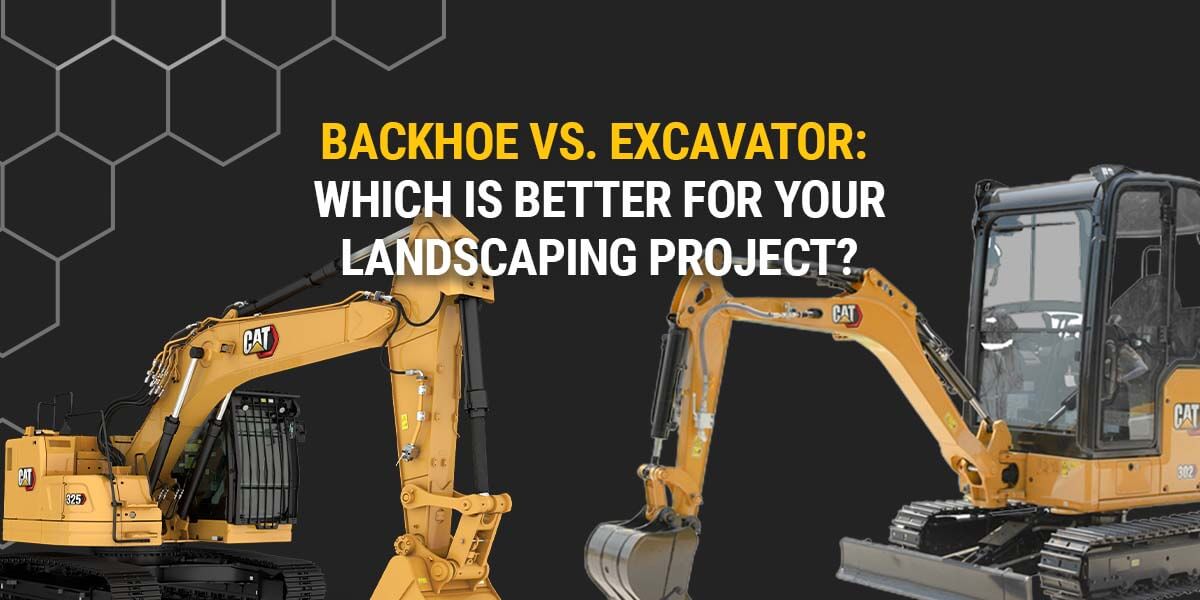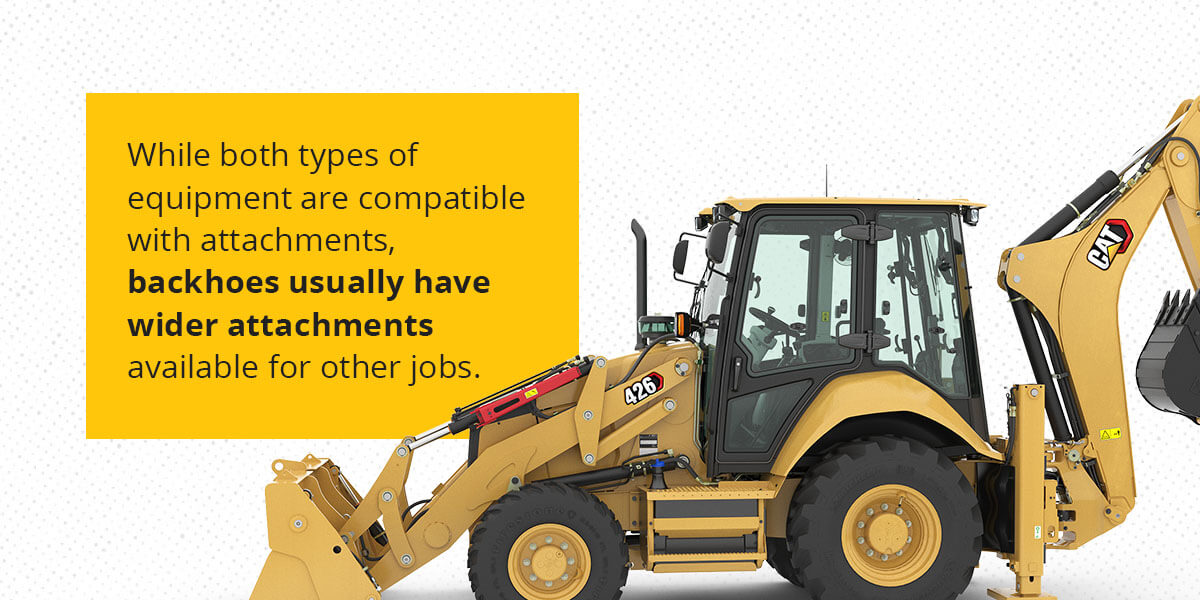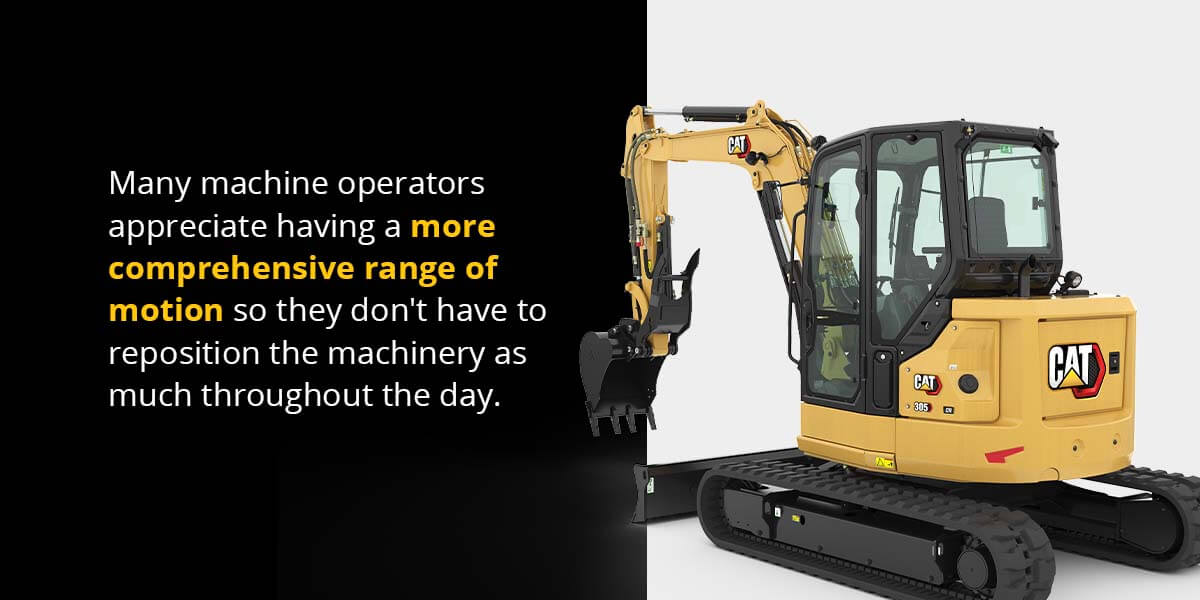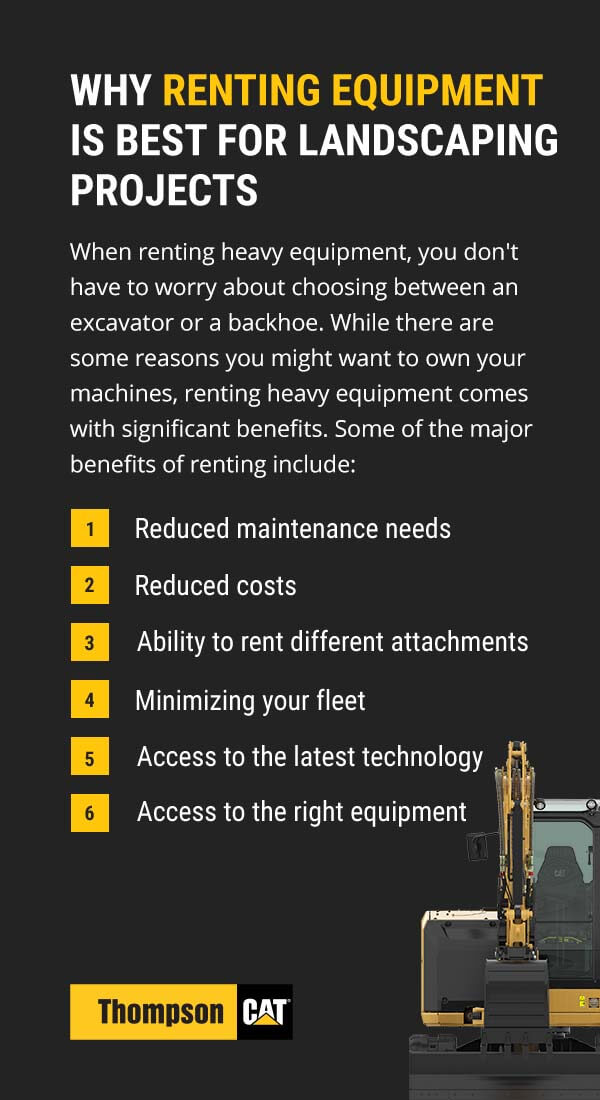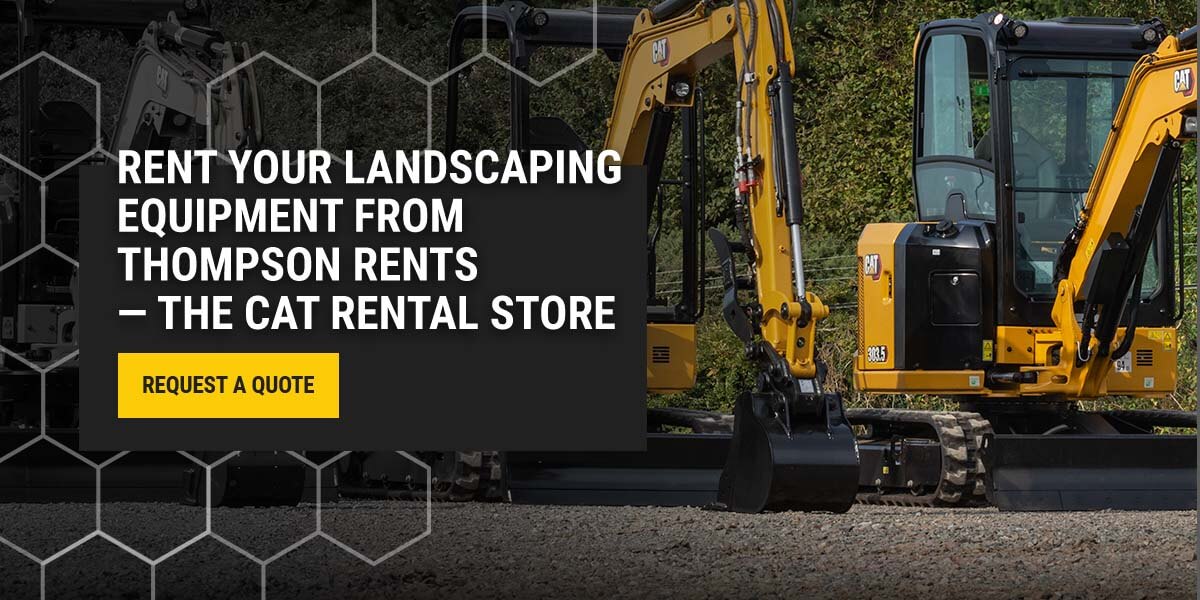Landscaping jobs require significant digging, whether planting flowers and trees, creating a feature, or digging a pool. Completing the work can take more time than necessary without the right equipment, resulting in lost revenue and decreased production.
Backhoes and excavators can both dig and help with your landscaping project, but there are some significant differences to consider. If you’re considering one of these machines, it’s essential to understand the difference between them to know how they can streamline your landscaping jobs and increase your revenue. This article explains each type of equipment and its applications.
What Is an Excavator?
An excavator is used for digging. Excavators come equipped with a dipper, chassis, digging bucket, and boom and are designed to dig and lift heavy materials. The machines typically move on tracks and are sometimes referred to as trackhoes.
Excavators are commonly used in landscaping projects to dig holes or trenches, demolish structures, or lift, move, and place heavy objects. You can also use attachments, such as augers or grapples, to achieve more with an excavator.
One of the significant benefits of excavators is that they can rotate 360 degrees while carrying heavy items. Excavator operators can quickly get the digging arm in the ideal position to complete their work. An excavator is suitable for heavy-duty digging or other large-scale projects.
Some benefits of an excavator for landscaping is that they can dig deep holes or trenches and lift heavy loads. You can create stunning features or quickly create terrain to achieve the goals of your landscaping project.
What Is a Backhoe?
A backhoe is a specific excavation machine that can complete specific tasks. Backhoes are more maneuverable and smaller than excavators, making them more versatile for some job types. These machines feature large loaders, a boom, a stick, and a bucket. Sometimes referred to as backhoe loaders, backhoes move on wheels. Similar machines on tracks are called track loaders.
Backhoes are used for various jobs, including landscaping projects. Backhoes boast high stability on uneven surfaces and can dig almost 20 feet deep. However, backhoes have a limited range of 200 degrees. Despite this, you can use various attachments with backhoes to help you complete landscaping projects. These attachments include forks, drills, plow blades, rakes, and plate compactors. Farms commonly use backhoes to complete various tasks, including light- and medium-duty digging applications. You can also use backhoes to move equipment and heavy materials.
Some benefits of a backhoe for landscaping are versatility, speed, and efficiency. You can easily switch between tasks or speed up your landscaping work to help you complete a job sooner.
What Is the Difference Between a Backhoe and an Excavator?
There are some distinct differences between an excavator and a backhoe that make them ideal for different tasks. Knowing the difference between the two pieces of equipment can help you determine which is suitable for your project. The two pieces of equipment have different sizes, versatility, and rotation capabilities, which can impact what you can accomplish at your job site.
Some of the key differences between the two types of machines include the following:
- Size: Backhoes are generally lighter and smaller than excavators, which are usually heavy and large. Since excavators are often larger and can generate more power, contractors typically use them on heavy-duty jobs, such as demolitions, driving piles, and large industrial projects. Backhoes are used for smaller means, such as loading, farming, construction applications, low- to medium-scale excavation, and snow removal.
- Versatility: Both machines can use different attachments that make them useful for various tasks. While both types of equipment are compatible with attachments, backhoes usually have wider attachments available for other jobs. As a result, backhoes are more versatile than excavators for some applications. You can also drive backhoes on roads, allowing you to move quickly between your work sites, unlike excavators, which require more complex transportation.
- Rotation ability: Excavators and backhoes have different rotational abilities and ranges. For example, most backhoe’s arms can only rotate about 200 degrees, limiting the operational capabilities of the machine. Excavators can turn in a complete circle, including the chassis and arm, allowing you to complete jobs with less restriction.
These differences can help you decide which machine is the best for your job. You may need a versatile machine or one with high rotation ability. You’ll also want to consider some aspects of your project in addition to the machines’ features.
Backhoe vs. Excavator: Which Is Better for Your Landscaping Project?
Backhoes and excavators have unique applications that could make them the right choice for your landscaping project. However, one type of equipment may be better than the other. Here are things you may want to consider and tips to help you decide whether a backhoe and excavator would be best for your specific landscaping project:
1. Project Size
You should match your machine’s size to your project’s size. You might choose an excavator if you have a large-scale project needing plenty of machinery power. Projects that are small- or mid-sized might be better suited to a backhoe.
While you can find large, heavy-duty backhoes and mini excavators, most excavators are larger than backhoes and might not be the best choice for a small project. You’ll also need to consider how much space you have available at the work site and how much power the job demands. Each machine can provide powerful performance depending on the scale of your job.
You’ll also need to consider the ground solidity at your job site since it’s one of the primary concerns of landscaping projects. Wheeled machines can sink into soft terrain, so a tracked machine may help preserve existing landscaping.
2. Mobility
Another factor you’ll need to consider is the mobility you need for each project and what the machines offer. One of the first things you’ll need to account for is the rotational range of each piece of equipment.
A backhoe can only rotate 200 degrees, which may be suitable for small-scale projects. However, many machine operators appreciate having a more comprehensive range of motion so they don’t have to reposition the machinery as much throughout the day.
Another mobility factor to consider is how easy it is to transport machinery from one job to the next. You can drive backhoes on regular roads and reach speeds up to 25 mph. You can’t drive excavators on the road, so you’ll have to wait for them to be loaded up and transported to the job site. Each machine has mobility benefits to consider before you make your final choice.
3. Types of Tasks
Another factor you need to consider is the types of tasks you’ll be completing at your job site. While an excavator and a backhoe can dig, there are other tasks that only one machine can handle, especially if you need attachments. Each piece of equipment has different attachments to accommodate various applications. The backhoe has more attachments than the excavator, allowing you to complete a wider range of tasks.
Before you choose one of these machines, consider what you might need for your project to ensure that you select equipment capable of completing your job requirements. You’ll also want to ensure you research the compatible attachments to help you make the best decision.
4. Professional Guidance
If you’ve considered the above tips and still don’t know which machine to choose, you can always seek help and advice from a heavy equipment professional. A professional understands the ins and outs of both types of machinery and their attachments, giving them the experience and skill to guide you toward a suitable machine based on your project.
Why Having Both Pieces of Equipment Is Most Beneficial
Some jobs are better suited to having a backhoe loader or an excavator or vice versa. However, many jobs should use both machines to boost productivity, speed and revenue. Many landscaping work sites have soft ground, and while an excavator can handle the job, you can make your job more efficient by using an excavator and a backhoe loader. Sometimes, you may need the applications of both machines to complete a job, so choosing just one may not be an option.
Understanding each machine’s role in landscaping can help explain why having both at your landscaping job site is the best choice. The roles of each type of equipment in landscaping projects are as follows:
- Excavators: These machines are ideal for digging large holes or trenches, though smaller excavators can dig small lots. Excavators excel at landscaping tasks designed to specifically handle digging, so they can help you create a pool or water feature or bury pipes or wiring.
- Backhoe loaders: These machines offer excellent versatility and quick task changes, allowing you to complete specific landscaping tasks quickly. Due to the two-sided design, backhoes can complete twice as many jobs. You can easily dig at a landscaping job and carry the dirt or other heavy materials to complete your work. You can quickly return to a dig position with a simple lever pull, allowing you to complete your work more efficiently. You’ll spend less time waiting and more time getting the job done.
Both machines make excellent additions to a landscaping project, allowing you to complete various tasks. Rather than trying to complete all the necessary jobs with one machine, you can have both pieces of equipment at your job site to complete your work. You can have two operators working on each piece of equipment or switch when one machine is more beneficial for a specific task than the other.
Having both pieces of equipment on site helps save time and streamlines the process, allowing you to complete your work quickly. You won’t have to wait to complete tasks or try to manage with only one machine. If you want to streamline your work timeline and increase your revenue, consider using both types of equipment at your next landscaping job.
Why Renting Equipment Is Best for Landscaping Projects
When renting heavy equipment, you don’t have to worry about choosing between an excavator or a backhoe. While there are some reasons you might want to own your machines, renting heavy equipment comes with significant benefits. Some of the major benefits of renting include:
- Reduced maintenance needs: One of the most important benefits of renting equipment for your landscaping project is that you won’t have to worry about maintenance or repair costs. The responsibility of maintenance and equipment upkeep falls on the company you’re renting from, allowing you to save time and resources.
- Reduced costs: Besides saving on maintenance costs, you’ll also gain access to both types of machines at much lower prices. Renting eliminates the need to market these machines for resale, pay for space to conduct maintenance or store equipment, and cover technician costs.
- Ability to rent different attachments: Renting allows you to rent equipment with various attachments to help you meet the specific needs of your landscaping project. Leasing terms are typically flexible, and you only have to rent when you need a machine for a job.
- Minimizing your fleet: Another benefit of renting equipment for landscaping projects is that you can reduce the size of your fleet. A smaller fleet means you don’t have to spend as much on storage or other aspects of owning heavy equipment.
- Access to the latest technology: Companies that rent out heavy machinery usually have access to the newest technology, allowing you to benefit from industry advancements without purchasing brand-new equipment. You also get the best landscaping equipment available at a lower cost without having to incur additional responsibilities, such as maintenance, upkeep or retaining resale value.
- Access to the right equipment: While using an excavator and a backhoe together can be beneficial, sometimes you may only need one type of machine for your landscaping project. Renting allows you to choose the equipment you need for the job, and you won’t have to worry about finding space to store unused equipment. You can return rented equipment you’re not using and keep the equipment you need for the job.
Renting your equipment for landscaping projects means you don’t have to worry about maintenance, upkeep, or costs associated with storage and resale. You’ll also gain access to the latest technology in heavy machinery, allowing you to take your landscaping projects to the next level.
Rent Your Landscaping Equipment From Thompson Rents
The right machine for your landscaping project depends on the specifics of your project. You may need an excavator to dig deep holes or a backhoe for speed and versatility. However, having both machines for your landscaping project offers the most benefits.
Rent your heavy equipment from Thompson Rents — The Cat Rental Store. We have numerous rental options available and affordable rates, allowing you to use one of our machines without hurting your budget. We’ll maintain the responsibility of maintenance, storage, and upkeep so you can focus on your work. Contact us today for a quick quote about how renting our equipment can benefit your next landscaping job!

